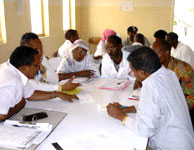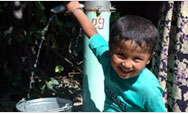Health Workers

|
| Source: Peggy Koniz-Booher |
It is estimated that more than 100 million health professionals provide care and treatment across the world. USAID's strategy to strengthen the ability of health workers to provide quality health care addresses quality improvement and workforce development.
Quality Improvement
Health care delivery is a complex set of activities. Even where donors provide training and other technical support, health systems offer many opportunities for additional, often dramatic, improvement. More than 50 assessments conducted in recent years show that the quality of care actually provided in large-scale programs falls short of evidence-based standards. Detailed studies have shown that following such standards can reduce case fatality rates by as much as 50 percent. At the same time, studies of the organization of health services frequently show high levels of inefficiency, with one study showing that 87 percent of resources were wasted.
The field of modern quality improvement is the most widely used approach to improve the quality and organization of health care in the United States and other developed countries. For more than 10 years, USAID has led a global initiative to adapt these approaches for use in developing countries. The basic principle of quality improvement is that regular providers can:
- Study the way they provide health care
- Identify concrete changes that might improve care, given local constraints
- Test those changes empirically
- Adopt changes that are successful

|
| Source: PHRplus |
As in the U.S. health system, the USAID initiative seeks to make improvement an integral part of health care, whereby providers routinely use simple analytical tools to find ways to improve their work. A large body of experience shows that providers in countries from Niger to Russia can produce measurable improvements. Furthermore, the need for these approaches is growing as developing countries face demanding new challenges, such as AIDS treatment, drug-resistant pathogens, and a growing burden of chronic diseases.
The initiative also includes other approaches to improving quality, such as accreditation and other regulatory strategies, more cost-effective provider training strategies, and systematic development of job aids. The initiative is also adapting a major recent innovation in quality improvement known as the "improvement collaborative,” which was developed in the United States to increase the pace and efficiency of improvements in health care. An improvement collaborative organizes teams from about 30 facilities to work in the same area of health care, with each team learning from the others. A second phase, the “expansion collaborative,” provides a framework for spreading improved practices through the health system. Ten countries are currently participating in the expansion collaborative initiative, which has addressed eight clinical topics.
Related Links
Workforce Development
In health care, human resources typically represent more than 70 percent of costs, but this area has been traditionally neglected by donors, and its management is widely regarded as weak. In high-burden AIDS countries, human resources faces a growing crisis from increasing patient loads combined with a shrinking and often demoralized workforce.

|
| Source: PHRplus |
Best practices in the field are well established in developed countries but not followed in most developing-country health systems. The Quality Assurance/Workforce Development (QA/WD) project focuses on expanding the evidence base for planning and managing human resources. A major strategy is a workforce assessment that examines not only the number of different kinds of providers available but also such quality issues as the time required to perform key tasks, the quality of care provided, and the impact of different types of education and training. The project also applies improvement methodologies to the challenge of developing a more effective workforce.
The technical lead in these areas is the Quality Assurance/Workforce Development (QA/WD) project, with substantial activities also carried out by the Health Systems 20/20 Program.
Other health worker-related projects at USAID:
|


